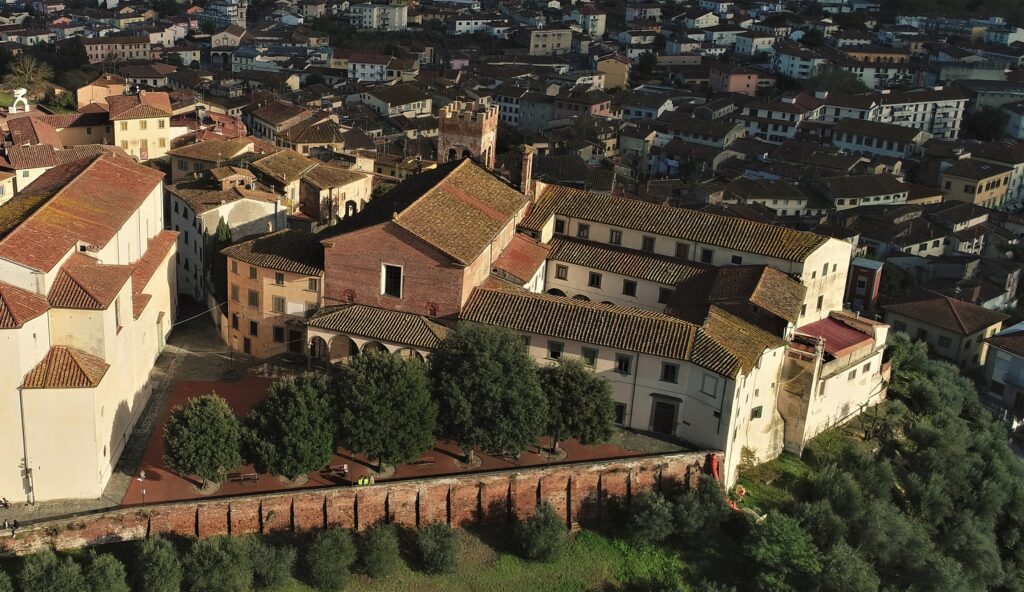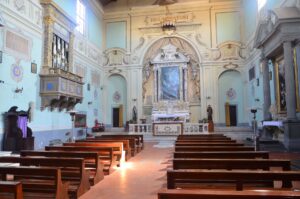- The Museum
- The Rooms
- Archaeology (1-6)
- Art (7-15)
- Room 7. Paintings, frescoes and Minor Guilds from the 13th to the 15th centuries
- Room 8. The great 16th-century paintings
- Room 9. 17th-century paintings
- Room 10. The jewellery room
- Room 11. 17th- and 18th-centuries paintings and jewellery
- Rooms 12-13. The sacred vestments
- Room 14. The relics of Giuseppe Montanelli (Fucecchio, 1813-1862)
- Room 15. The Arturo Checchi collection (Fucecchio 1886 – Perugia 1971)
- Nature (16-17)
- Collections
- Temporary exhibitions
- Events
- Multimedia
- Surroundings
- Versione italiana
- The Museum
- The Rooms
- Archaeology (1-6)
- Art (7-15)
- Room 7. Paintings, frescoes and Minor Guilds from the 13th to the 15th centuries
- Room 8. The great 16th-century paintings
- Room 9. 17th-century paintings
- Room 10. The jewellery room
- Room 11. 17th- and 18th-centuries paintings and jewellery
- Rooms 12-13. The sacred vestments
- Room 14. The relics of Giuseppe Montanelli (Fucecchio, 1813-1862)
- Room 15. The Arturo Checchi collection (Fucecchio 1886 – Perugia 1971)
- Nature (16-17)
- Collections
- Temporary exhibitions
- Events
- Multimedia
- Surroundings
- Versione italiana
- The Museum
- The Rooms
- Archaeology (1-6)
- Art (7-15)
- Room 7. Paintings, frescoes and Minor Guilds from the 13th to the 15th centuries
- Room 8. The great 16th-century paintings
- Room 9. 17th-century paintings
- Room 10. The jewellery room
- Room 11. 17th- and 18th-centuries paintings and jewellery
- Rooms 12-13. The sacred vestments
- Room 14. The relics of Giuseppe Montanelli (Fucecchio, 1813-1862)
- Room 15. The Arturo Checchi collection (Fucecchio 1886 – Perugia 1971)
- Nature (16-17)
- Collections
- Temporary exhibitions
- Events
- Multimedia
- Surroundings
- Versione italiana

Abbatial Church of San Salvatore
Founded by Count Cadolo at the bridge over the Arno, the Church of San Salvatore is mentioned for the first time in a document dated 986. Flanked around the year 1000 by a Benedictine monastery, both buildings were rebuilt on a hill near the Salamarzana castle (today’s Poggio Salamartano) following the disastrous flooding of the river in 1106.
After an initial period of considerable wealth, at the end of the 13th century, after the extinction of the Cadolingi lineage, the church went through a period of decline: it was entrusted to the Franciscans, then to the Clarisse who still reside there.
Outside, elements dating back to the early medieval period, are still visible, such as the small side arches or the remains of mullioned windows and arches in decorated terracotta on the facade.
The robust bell tower that rises on the rear side can also be referred to the medieval age. Renovation and expansion works that followed one another from the sixteenth to the eighteenth century gave the church its current appearance.
Inside the church, with a single wide nave according to the typical Franciscan scheme, the main altar in Carrara marble, built in the first decade of the eighteenth century, stands out. From the same period is the above painting on canvas of Christ on the cross with the Madonna, Magdalena and San Giovanni. The side altars, of Vasari style, were erected between the end of the 16th and the beginning of the 17th century, but have undergone subsequent alterations. On the left side there is a wooden crucifix of valuable quality by an unknown master of the 16th century, an object of particular veneration. Also on the left side is a rare organ from 1626 by the Lucca masters Andrea and Cosimo Ravani.
The story of the Dolorous Crucifix
The Dolorous Crucifix, after a careful restoration, has returned to its original accommodation in the monastery of San Salvatore. The sculpture, which probably dates back to the first half of the 14th century, is part of the group of “Painful” Crucifixes who wanted to inspire the faithful to reflect on the sufferings of Christ.
The city of Fucecchio has a strong bond with this sculpture to which, over the centuries, numerous miracles have been attributed: the canon Giulio Taviani, in 1774, tells of the resurrection of the son of a knight from Lucca who, who died in his mother’s womb, returned to move in front of the cross.
Hours
from Tuesday to Friday 10.00-13.00
Saturday and Sunday 16.00-19.00
© 2021. Città di Fucecchio – P.IVA e CF 01252100480
Credits – Privacy Policy



